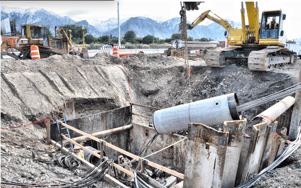WHY CONCRETE - COST
Life-Cycle Cost
 A common misuse of the concept of least cost is the adoption of that analysis when choosing underground drainage pipe material. Least cost variables, including material cost, material life, inflation rates, replacement cost and residual values are vital in the design of roadway pavements. These same criteria, however, just don’t work when attempting to predict the service life for pavements and underground utilities working together as a system. The underground material service life must, in all cases, exceed the design life of the entire roadway system. It would be inconceivable to replace a concrete roadway surface one year and reach the material service life of an underground culvert the next, necessitating an early re-replacement of the road.
A common misuse of the concept of least cost is the adoption of that analysis when choosing underground drainage pipe material. Least cost variables, including material cost, material life, inflation rates, replacement cost and residual values are vital in the design of roadway pavements. These same criteria, however, just don’t work when attempting to predict the service life for pavements and underground utilities working together as a system. The underground material service life must, in all cases, exceed the design life of the entire roadway system. It would be inconceivable to replace a concrete roadway surface one year and reach the material service life of an underground culvert the next, necessitating an early re-replacement of the road.
For this reason, Life Design should be used to evaluate all underground drainage culverts and storm sewers. The Life Design concept encompasses all factors that could potentially lead to the premature repair or replacement of a roadway surface. Basically, materials are chosen for use based on their ability to remain in service for, at a minimum, of the design life of the roadway system.
Life Design takes into consideration material service life, defined as the long term structural strength of either the pipe itself or of the soil/pipe interaction system insuring that required design strength will not decline during the life of the system. Additionally, the pipe itself must maintain its hydraulic capacity, not experiencing losses due to changes in the pipe wall (rippling) or as a result of deflection.
The ability of a pipe material to survive unanticipated external events including fires, flashovers and flooding is also a major design element of Life Design. Finally, protecting the environment by insuring that pipe materials do not leach toxic substances into our nations estuaries will help maintain our fragile natural resources.
The Life Design “costs” of a system are inclusive of all of the elements of Life Design and provide for a more accurate gauge of the fully absorbed cost of the asset. Initial material cost, design costs, soil testing (in the case of flexible materials), installation costs and post installation costs are all evaluated using the Life Design parameters as a minimum. Repair and maintenance costs should be minimal at best and replacement during the life of the system should not be an option.
Concrete pipe will easily meet all of the demands of Life Design as it remains the strongest, most hydraulically efficient, durable and environmentally friendly pipe available today.

